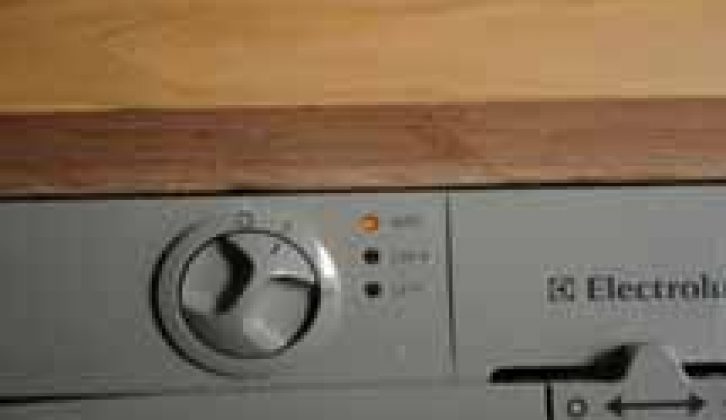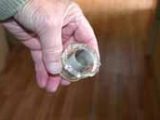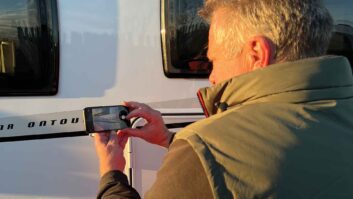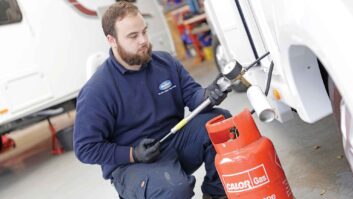The beginning of a new touring season is the perfect time to start making sure everything inside your motorhome is in working order, because it’s surprising how often people arrive on site only to find items that were perfectly okay last season appear to have given up the ghost during the winter lay-up.
Here are some of the things we think you should check before you set off on your first trip this year.
The water system
Clean the water filter
[tl:gallery index=1 size=215×129]
Inboard water pumps usually have a gauze filter fitted either in the inlet port of the pump or in the pipe leading to the pump. Importantly, this type of filter is too coarse to trap bacteria. Its purpose is to prevent tiny bits and pieces of debris from getting into the pump and damaging it. Obviously, the filter needs cleaning periodically and now is a good time to do it.
The filter can be removed either by unscrewing it (as shown) or by removing the inlet pipe or hose to the pump, and then gently easing it out of the inlet port with a thin blade screwdriver. Then, hold the filter under a running tap to wash the debris out.
Flush out and sterilise the tank
[tl:gallery index=2 size=215×129]Although both inboard and underfloor water tanks can be drained, there will always be some residual water left in them. This makes both tanks breeding grounds for bacteria. Simply flushing them out isn’t the answer – the bacteria will still be there.
The remedy is to treat the tank with a suitable solution that will kill all the bacteria. There are a number of water treatments (biocides) available, of which Aqua Sol is one of the best known.
Although there is only residual water in the tank, add enough water treatment via a watering can to half the tank’s capacity. Fill a watering can to its maximum level and add the correct number of capfuls of treatment. Then pour the mixture into the tank, via either the tank’s own filler or the motorhome’s external filler. Then leave the solution to do its job for the prescribed amount of time.
Sterilise and flush out the system
[tl:gallery index=3 size=215×129]
As well as the residual water left in the tank after it has been drained, there will also be some in the rest of the motorhome’s water system. You’ll need to treat this as well to kill the bacteria. So having treated the water tank, you now need to prime the whole system using the treated water.
You should have left the taps and shower controls open after draining down the system prior to the winter lay-up. If you didn’t, open them now, switch on the pump and, as the air is expelled from each tap and the shower, close it.
Once the system has been filled, leave it so that the water treatment solution can kill off any bacteria that has remained in the system over the winter. The time required for this will be stated in the treatment instructions, but it won’t hurt to leave the system primed for several hours.
Finally, fill the tank to its maximum capacity with fresh water and flush the whole system through. Not only will this ensure that you have clean water throughout, it will also enable you to confirm that no frost damage has occurred to the taps or shower controls during the lay-up.
The gas system
You also need to check the appliances that run on LPG in case any creepy-crawlies have got into the system over the winter and caused problems. Spiders can be a particular nuisance if they weave webs anywhere near the gas jets. So having turned on the gas supply at the cylinder, operate each appliance in turn.
The fridge
[tl:gallery index=4 size=215×129]Switch on the fridge and check that the LED light remains on (pictured, right). Leave the fridge on gas until you are happy that the freezer compartment is cooling down. If it fails to do so, our advice is to have the system checked over at your dealer’s or by a CORGI-registered gas technician.
The hob/oven
The easiest way to check your cooker is to ignite one of the burners on the hob. If the gas-and-air mixture is correct, the flame will be blue.
However, if it has yellow tips, the mixture is incorrect and needs adjusting – a job that should be carried out by a suitably qualified technician at your dealer or by a CORGI registered technician.
Space and blown-air heating
Ignite the space heater and, again, look at the flame, in the inspection chamber which should be blue. If it is any other colour, turn off the heater and do not use it until it has been thoroughly checked out at your dealer’s workshop or by a CORGI-registered technician. Once you are happy that the heater is working correctly, operate the blown-air system to ensure that there is no problem with the fan. Occasionally, it will ‘scream’ a bit if it hasn’t been used for a long time, but the noise usually stops fairly quickly.
If it doesn’t, have it checked by your dealer. At this stage, it is worthwhile checking that the blown-air system also works on mains electricity. When hooked up, switch on the heating element and operate the fan. If the blown air coming out of the vents isn’t hot after a few minutes, have the system checked by your dealer.
The electrical systems
There isn’t likely to be any problem with the motorhome’s mains electrical system, but the same may not be true of the 12V system. The most likely cause of problems with the 12V system is corrosion, either at the contacts of the various appliances or at the 12V earth.
12V lights
Switch each light on in turn. If any doesn’t light up, turn off the power and remove the diffuser. Then remove the tube or bulb (making sure not to touch the glass of a halogen bulb) and clean the contacts by rubbing them with a piece of fine emery cloth. If the light still doesn’t work, check and clean the contacts on the switch if possible.
The chances are that cleaning the contacts will solve the problem, but if it doesn’t, disconnect the leisure battery earth clamp and find the 12V earth on the chassis. Undo it and thoroughly clean all the surfaces to ensure a good contact between them. Once you’ve replaced the battery’s earth clamp, test the light again. If the problem persists, have the system checked by a qualified electrician.
The toilet
The waste tank
[tl:gallery index=5 size=215×129]When a motorhome is laid up for long periods (especially during the winter), the blade of the waste tank should be left slightly open so that it does not stick to the lipseal. However, many people forget to do this and leave the blade in the closed position. This can also result in the lipseal being damaged if residual water between the two elements freezes.
Having removed the waste tank, spray a small amount of Thetford Maintenance lubricant on the blade and lipseal and carefully open and close the blade a few times. Close the blade and then check that there has been no damage by pouring a little water onto its surface. If all is as it should be, the water should remain and not drip down into the waste chamber. If there is a leak, you will need to replace the lipseal. Once you’re satisfied there is no leak between the lipseal and the blade, you can charge the waste chamber.
Toilet freshwater tank
If you’ve left water in the fresh-water chamber of the toilet, you should now top it up and flush it through the system, as there will almost certainly be some algae in the tank – easily recognised as black streaks in the water. It may be necessary to fill and flush more than once before the water is clean. Once you have got rid of all the algae, charge the tank, adding some Thetford Aqua Rinse in correct proportion to keep the water fresh.
Cassette blinds
[tl:gallery index=6 size=215×129]Cassette blinds should not be left in the closed position as it can weaken the springs. However, many people ignore this advice and do leave them closed during long lay ups. Check the strength of the springs by opening and closing each blind in turn.
If the blinds do not fully retract to the open position it means that the springs have weakened and need retensioning. It will depend on the type of blind fitted in your motorhome but you may be able to do the retensioning yourself. But be warned, the job needs to be done extremely carefully or you could make matters worse!
You will need to find the adjuster, which is usually on the side of the cassette. It should have a slot to take a flat-bladed screwdriver. Insert the screwdriver and push the adjuster inwards while holding the screwdriver to prevent the spring from coming undone. If it unwinds you will have to rewind it until it is again fully tensioned – a job which sounds easy but really is anything but. Once you have pushed the adjuster into the cassette turn it clockwise to tension the spring. Don’t rush the job, because if the screwdriver slips the spring will lose its tension, and you will have to start from scratch.
Once you are happy that the tensioning is correct, gently release the pressure on the screwdriver to allow the adjuster to reseat itself in the cassette. If you fail, or the spring cannot be tensioned correctly, you will need to have the cassette checked out professionally.





















